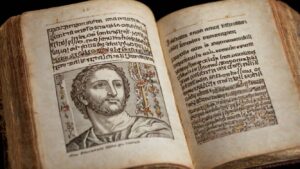Meaning of 7 Candles in the Bible: Spiritual Revelation
In biblical tradition, the seven candles, exemplified by the seven-branched menorah, symbolize divine presence, spiritual completeness, and enlightenment. Originating from the Book of Exodus, the menorah was crafted from pure gold to signify sanctity and divine light in the Tabernacle.
The seven lampstands mentioned in Revelation represent the spiritual states of the seven churches in Asia Minor, highlighting divine oversight and moral guidance. The recurring motif of the number seven underscores themes of divine perfection and covenant fulfillment.
Understanding these symbols offers insights into the theological and liturgical significance revered in both historical and contemporary contexts for deeper exploration.
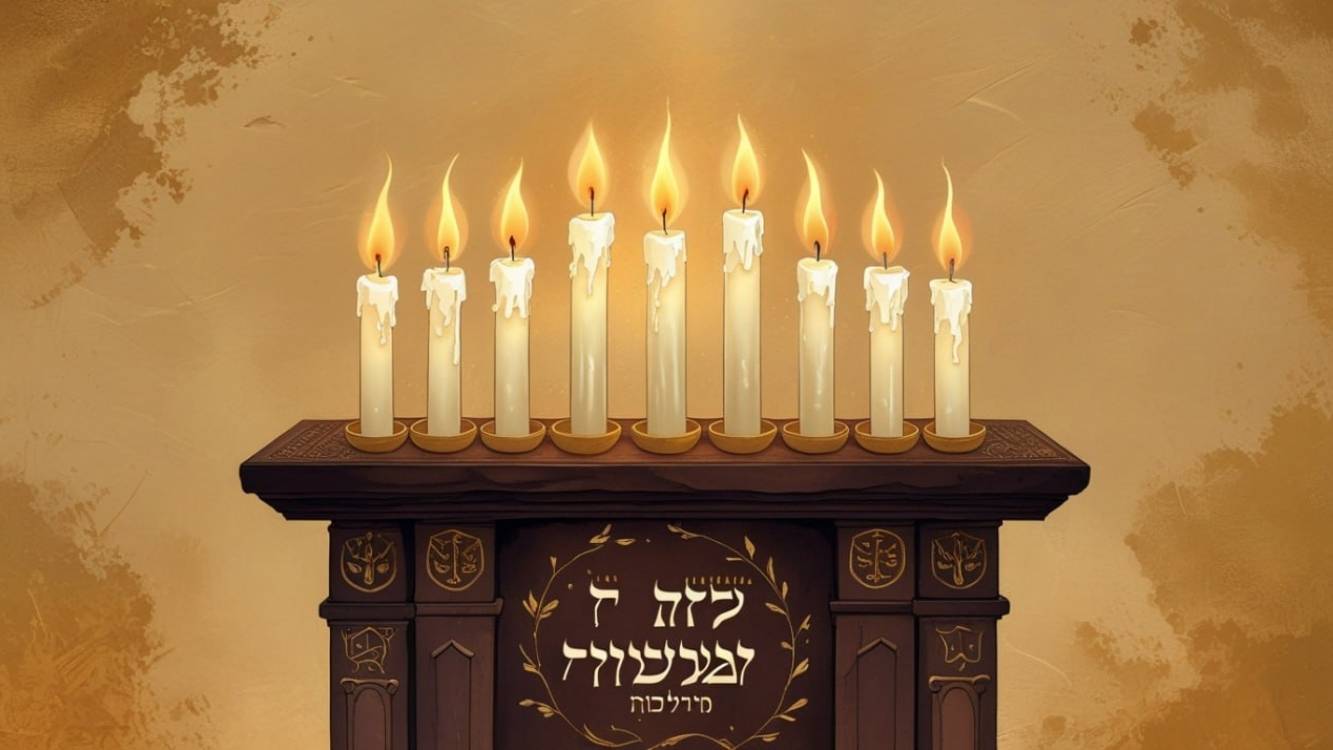
Meaning of 7 Candles in the Bible: Symbolism and Spiritual Revelation
| Aspect | Details |
|---|---|
| Symbol | 7 Candles / 7 Lamps |
| Biblical Meaning | Completeness, divine perfection, fullness of the Holy Spirit |
| Key Scripture | Revelation 1:12-13, Revelation 4:5 |
| Spiritual Symbolism | Represents the sevenfold Spirit of God, guidance, and spiritual light |
| Tabernacle Reference | The menorah (Exodus 25:31-37) – seven-branched lampstand in the Holy Place |
| Prophetic Insight | Illuminates God’s presence, wisdom, and divine truth |
Seven-Branched Menorah

The seven-branched menorah, an ancient and enduring symbol in Jewish tradition, is deeply rooted in biblical texts and carries profound theological significance.
Originating in the Book of Exodus, the menorah was meticulously described by God to Moses as part of the Tabernacle’s furnishings (Exodus 25:31-40). Crafted from pure gold, its design includes a central shaft with three branches extending from each side, culminating in seven lamps.
Its illumination not only served a practical function in the sanctuary but also symbolized divine presence and enlightenment. The menorah’s structure, with its symmetrical branches and central light, reflects a divine order and unity.
Scholarly interpretations often connect it to the Tree of Life, signifying spiritual wisdom and eternal divine light.
Symbolism in Leviticus
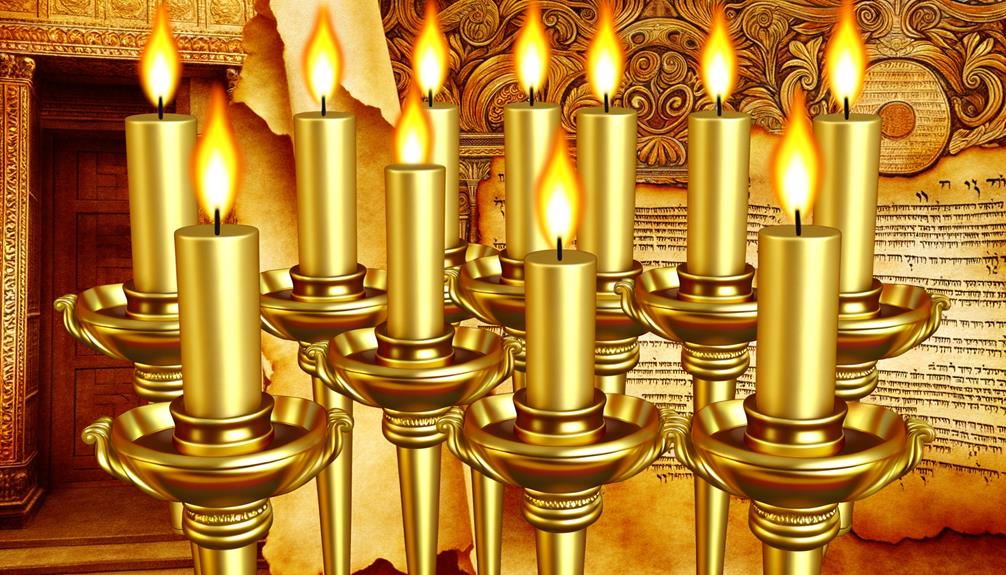
Leviticus, a central text in the Torah, contains a rich tapestry of symbolism that underscores the rituals and laws governing ancient Israelite worship and ethical conduct.
The text provides profound insights into the sacred practices of the Israelites, offering a deeper understanding of their spiritual life and societal norms.
Symbolism in Leviticus includes:
- Sacrificial rituals: Representing atonement and reconciliation with God.
- Clean and unclean animals: Distinguishing between purity and impurity.
- Holy convocations: Marking sacred times for communal worship.
- Priestly garments: Signifying the sanctity and responsibility of priesthood.
These symbols collectively articulate a framework of holiness and devotion, central to Levitical teachings.
Prophetic Visions in Zechariah

In the prophetic visions of Zechariah, the imagery of the temple lampstand featuring seven lamps emerges as a focal point of divine revelation.
This vision, detailed in Zechariah 4:1-14, symbolizes the omnipotent presence and guidance of God through the Holy Spirit.
The seven lamps, often interpreted as representations of God’s perfect vision and sovereign power, underscore themes of spiritual enlightenment and divine intervention.
Zechariah’s Temple Lampstand
Zechariah’s prophetic vision of the temple lampstand, described in Zechariah 4:2-6, serves as a profound symbol of divine presence and guidance within the Israelite community.
This vision features a golden lampstand with a bowl on top, flanked by two olive trees, providing continuous oil to the lamps. The imagery conveys several critical theological and spiritual insights:
- Divine illumination: The lampstand symbolizes God’s perpetual light guiding His people.
- Uninterrupted supply: The olive trees guarantee the lamps’ constant burning, signifying God’s unceasing provision.
- Holy temple: The setting underscores the sanctity and centrality of the temple in worship.
- Prophetic encouragement: The vision reassures the community of God’s support during the temple reconstruction.
Such rich symbolism underscores the depth of Zechariah’s vision, offering profound insights into divine-human interaction.
Symbolism of Seven Lamps
Building upon the profound imagery of the temple lampstand, the symbolism of the seven lamps in Zechariah’s prophetic visions offers a deeper understanding of divine revelation and eschatological promise within the biblical narrative.
In Zechariah 4:2, the seven lamps signify the omnipresence and omniscience of God, representing His all-seeing eyes that traverse the earth. This imagery underscores a theological assertion that God’s divine wisdom and providence are ever-present and active in guiding His people.
Additionally, the seven lamps illuminate the path for Zerubbabel, emphasizing divine assistance in the reconstruction of the temple. This prophetic symbolism encapsulates the hope for restoration and the fulfillment of God’s covenant promises, reinforcing themes of vigilance, guidance, and divine sovereignty.
Seven Lampstands in Revelation
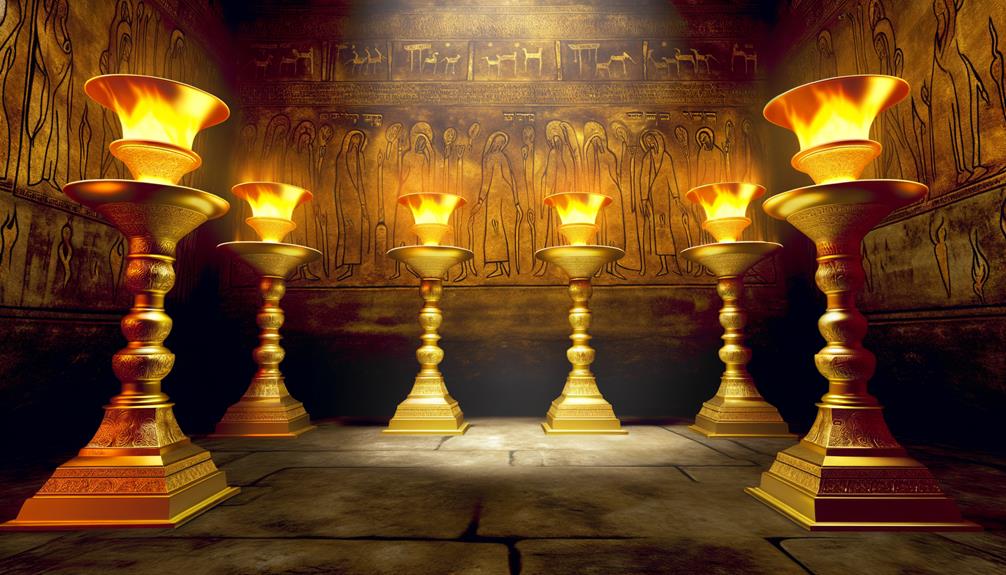
The imagery of the seven lampstands in the Book of Revelation carries profound symbolic significance, representing the seven churches addressed in the text.
Each lampstand is emblematic of a particular church’s spiritual condition and mission, underscoring the interconnectedness between heavenly visions and earthly congregations.
This symbolism offers a multifaceted perspective on the divine mandate and the responsibilities bestowed upon these early Christian communities.
Symbolism of Lampstands
Often interpreted as a profound symbol of divine presence and guidance, the seven lampstands in the Book of Revelation represent the seven churches of Asia Minor, serving as a metaphor for spiritual illumination and ecclesiastical purity.
These lampstands provide rich theological symbolism, reflecting the following key aspects:
- Divine Illumination: Representing God’s light in the world.
- Ecclesiastical Witness: Symbolizing the church’s role in bearing witness to Christ.
- Spiritual Vigilance: Emphasizing the need for perpetual readiness and holiness.
- Judgment and Accountability: Highlighting the churches’ responsibilities before God.
These elements collectively underscore the multifaceted symbolism of the lampstands, inviting deeper reflection on their theological and spiritual significance.
Churches Represented in Revelation
Expanding upon the rich symbolism of the lampstands, the seven churches represented in the Book of Revelation each embody distinct characteristics and challenges that offer profound insights into the spiritual health and dynamics of early Christian communities.
These churches—Ephesus, Smyrna, Pergamum, Thyatira, Sardis, Philadelphia, and Laodicea—serve as archetypes, reflecting a spectrum of virtues and shortcomings. For instance, Ephesus is commended for its perseverance but criticized for losing its first love, while Laodicea is rebuked for its lukewarm faith.
The lampstands symbolize both illumination and accountability, underscoring the divine expectation of spiritual vigilance and moral integrity.
Analyzing these churches provides a nuanced understanding of the diverse experiences and spiritual states within early Christianity, essential for contemporary theological reflection.
Divine Completeness

In biblical symbolism, the number seven frequently represents divine completeness and perfection, reflecting God’s creation and the spiritual significance attributed to this sacred numeral. This concept is deeply woven into the fabric of scriptural narratives and theological constructs.
- Creation: God created the world in six days and rested on the seventh, marking the week’s completion.
- Covenants: The sevenfold covenant blessings signify divine commitment.
- Sacred Feasts: Numerous Jewish festivals span seven days or involve seven specific elements.
- Judgment and Redemption: In Revelation, seven seals, trumpets, and bowls signify thorough divine judgment and redemption.
- Spiritual Fulfillment: The sevenfold Spirit of God, referenced in Isaiah 11:2, encapsulates complete spiritual endowment.
These instances underscore the theme of divine completeness, portraying seven as a number of spiritual wholeness and divine perfection.
Liturgical Practices
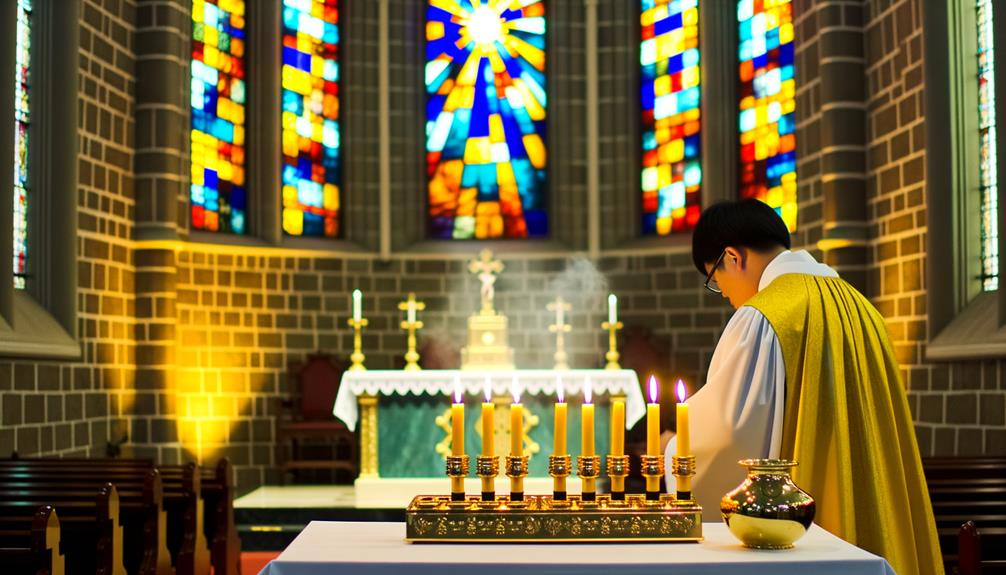
The symbolic significance of the number seven extends into liturgical practices, where it is employed in various rituals and ceremonies to embody divine completeness and spiritual perfection.
In Christian liturgy, the use of seven candles is particularly prominent in the menorah, a seven-branched candelabrum, which holds historical and theological importance.
The menorah, originally used in the Jewish Temple, represents the presence of God and the light of divine wisdom.
Additionally, in the Roman Catholic tradition, the seven candles often symbolize the seven sacraments, each representing different facets of spiritual grace.
The recurring motif of seven in these practices underscores a profound theological assertion: the number seven is not merely numerical but a representation of holistic spiritual truth and divine order.
Modern Interpretations

How has the symbolic meaning of the seven candles evolved in contemporary religious and cultural contexts?
In modern times, the seven candles often transcend their biblical origins, resonating with broader spiritual and cultural narratives. Contemporary interpretations emphasize their universal symbolism and adaptability.
- Ecumenical Symbolism: The seven candles are increasingly viewed as a unifying symbol across various Christian denominations.
- Interfaith Dialogue: They serve as a bridge in interfaith discussions, representing common spiritual themes.
- Personal Reflection: Individuals use the symbolism for personal meditation and spiritual growth.
- Cultural Adaptations: The seven candles are incorporated into cultural festivals and secular ceremonies.
- Artistic Representation: Artists employ the motif to explore themes of light, spirituality, and human connection.
These modern interpretations highlight the enduring and evolving relevance of the seven candles.
Conclusion
The seven candles in the Bible serve as multifaceted symbols, ranging from the sacred Menorah in Leviticus to the prophetic visions in Zechariah and the eschatological lampstands in Revelation.
These elements collectively underscore themes of divine completeness and spiritual enlightenment.
Liturgical practices and modern interpretations further illuminate their enduring significance.
Consequently, the septenary symbolism encapsulates a theological richness that transcends temporal bounds, reaffirming its relevance from the Iron Age to contemporary religious thought.


